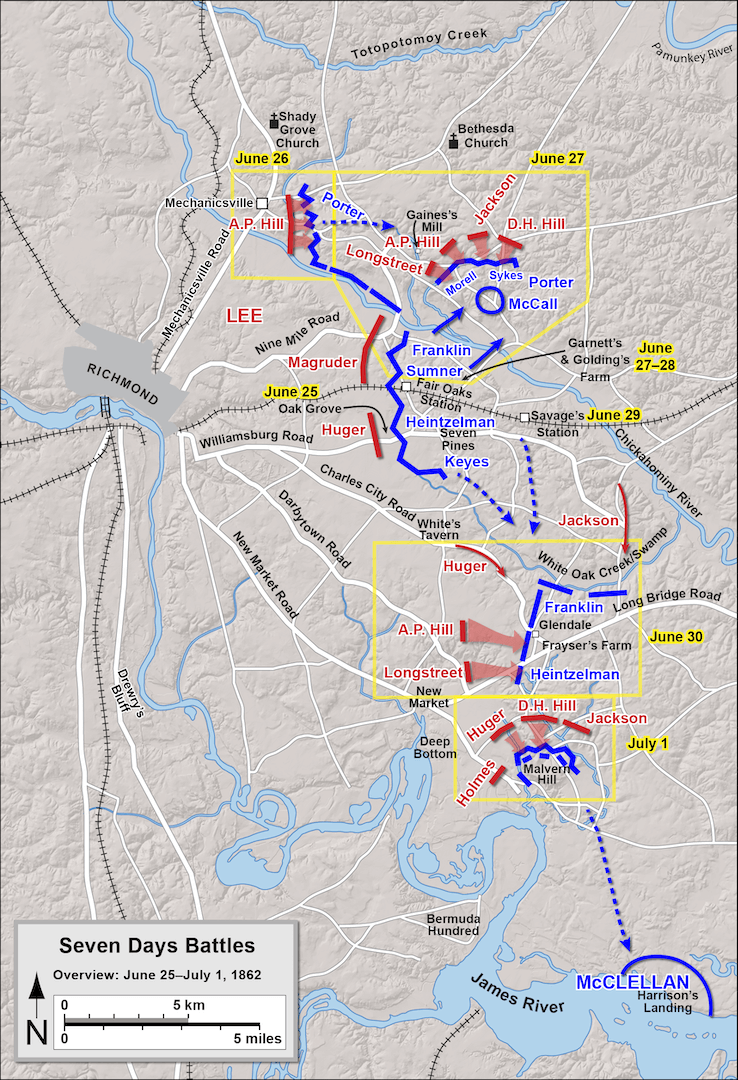The Seven Days’ Battles took place from June 25-July 1, 1862. It was the culmination of Union Gen. George McClellan’s Peninsula Campaign in his drive for the Confederate Capital of Richmond. This event witnessed the rise of Gen. Robert E. Lee, where seven battles were fought over seven days as part of the Defense of Richmond.
Located in Hanover and Henrico County, Virginia, east of Richmond, the Seven Days’ battlefield today sits on the Richmond National Military Park. Notable sites include the Watt House at Gaines’s Mill and the Federal artillery display on Malvern Hill.
Union Gen. George McClellan’s 100,000-strong army had reached the gates of Richmond after his drive up the Peninsula.
On May 31, 1862, at the battle of Seven Pines (Fair Oaks), Confederate Gen. Joseph E. Johnston was wounded. And Confederate President Jefferson Davis decided to place his military advisor, Gen. Robert E. Lee, in command of the army, a decision that would lead to the rise of Gen. Robert E. Lee and have a significant influence on the course of the war.
Gen. Lee’s first decision was to order a defensive network of earthwork fortifications to encircle Richmond, an order for which his men would call him “The King of Spades.”
With the arrival of Stonewall Jackson from the Valley bringing Confederate numbers to 90,000 men, Gen. Lee determined the best defense plan was to go on the offense.
This initiated a series of bold but costly battles over seven days.
Gen. McClellan struck first on June 25, around a swampy area at Oak Grove, in an attempt to obtain Richmond and the York River railroad. With this action indecisive, Gen. Lee seized the initiative by attacking the Union along Beaver Dam Creek the next day.
This resulted in the Federals falling behind the Boatswain Creek east of Gaines’s Mill on high ground.
At Gaines’s Mill on June 27, there followed a series of bold and costly Confederate charges where Gen. Lee ordered a massive combined attack.
This bold decision resulted in Gen. Lee’s first victory. Afterward, the cautious Gen. McClellan abandoned his plans to take Richmond and fell back along his supply line towards the James River.
The Seven Days’ battles began with small-scale fighting at Garnett and Golding Farm on June 27 and 28. The Confederates struck the Union rear at Savage’s Station on June 29 but to no avail.
Lee’s last chance to get at the Federals took place on June 30th at Glendale (Frayser’s Farm). Due to delays and confusion by Stonewall Jackson to the north at White Oak Swamp, it allowed Union Gen. McClellan to withdraw just above the James River in a well-positioned defensive line at Malvern Hill.
On July 1 at Malvern Hill, Lee launched determined frontal assaults against the strong Federal defenses with commanding artillery positions. These futile Confederate frontal assaults resulted in mass casualties, and the Confederates failed to take the position. However, it ultimately ended up being a strategic victory for the Confederates and a success for Lee. Gen. McClellan retreated to a safe position next to the James River at Harrison’s Landing, and Richmond was saved from a Federal takeover.
This campaign resulted in the Federals being driven off the Peninsula after sustaining 16,000 casualties. Gen. Lee emerged victorious at the cost of 20,000 casualties, but from this battle, the Army of Northern Virginia came into existence, and Robert E. Lee emerged as the Savior of the South.
Confederate success continued afterward at Cedar Mountain and Second Manassas, which set the stage for the first invasion of the North, with the Maryland Campaign ending at Antietam.

Ready to explore the battlefield for yourself? Browse our full selection of American Civil War Battlefield Tours.
Please contact us if you have any questions about our tours or services.